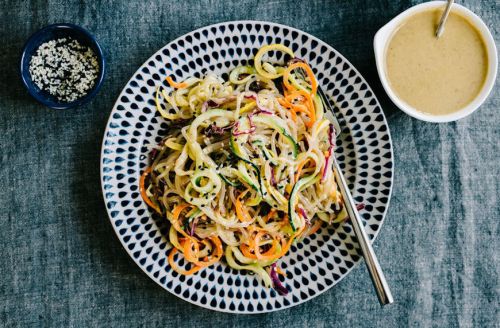It feels like everyone and their sister these days is nixing gluten or dairy from their diets. And it makes sense: many people have an intolerance to these foods, which can lead to a slew of extremely unpleasant side effects, from bloating to indigestion and nutrient deficiencies.
Yet, when you need to get rid of both, it means ditching a lot of different foods, making meal prep and eating out way harder. Plus, is it even a good idea to do both at the same time? Before saying goodbye to your favorite charcuterie plate, here’s what the experts have to say about the safety and necessity of a gluten and dairy free diet.
Why would someone need to cut out gluten?
People who have Celiac disease, a non-Celiac gluten intolerance, or a wheat and gluten allergy all cannot eat gluten for various different reasons. In the case of Celiac, it’s an autoimmune disease where the presence of gluten prompts the body to attack the small intestine, which can cause bloating, digestive distress, malabsorption, and long-term health problems like anemia and even infertility. People with a non-Celiac gluten intolerance do not have Celiac but still experience serious digestive issues when they eat gluten. And for someone with a wheat and gluten allergy, they might experience rashes, hives, sneezing, or a runny nose after eating wheat products.
There’s also research showing that gluten can cause leaky gut, says Sam Presicci, RD, CPT, and dietitian for Snap Kitchen. “When you eat gluten, it travels through your stomach and into your small intestine, where its presence initiates the release of zonulin,” she explains, a type of protein. “Zonulin signals the tight junctions of intestinal wall to open. As their name implies, tight junctions are meant to stay sealed, making sure that the foods that enter your digestive tract never make their way to other parts of your body,” she says.
For most healthy adults, this isn’t a big deal—your tight junctions can generally repair the damage after the meal and you go unaffected by it. But for people who have Celiac disease or a non-Celiac gluten intolerance, some research shows that they release higher levels of zonulin in response to gluten, which can prevent the tight junctions from being able to repair the damage. They remain open, which can lead to leaky gut, Presicci says.
And what about dairy?
When it comes to dairy, many people are lactose intolerant, where dairy causes symptoms like bloating or digestive distress. “Quality also matters when it comes to dairy. Someone may do better with raw, 100-percent grass-fed cow’s cheese compared to a more conventional option,” says Presicci. Plus, some of the additives and growth hormones in conventionally raised dairy may lead to inflammation, she adds, which could make the aftermath of that cheese plate tricky.
Additionally, while lactose intolerance is one issue many adults have with dairy, difficulty digesting casein (the primary protein in dairy) can cause issues, too. “It’s important to know that not everyone reacts to casein,” she says, “but those with digestive issues or gut inflammation will likely have more issues with casein than those without those same issues.”
Why would someone need to try a gluten- and dairy-free diet?
Basically, cutting out gluten and dairy can potentially help someone eliminate two major sources of inflammation. “In those with Celiac disease, casein can cross-react with gluten, meaning the body mistakes the casein for gluten, causing inflammation and furthering issues of leaky gut,” says Pressici. For those people, cutting gluten and dairy can tame inflammation all around, although it’s not necessary for everyone who has Celiac.
“Those with autoimmune conditions (like Hashimotos Thyroiditis, for example) will often greatly benefit from a gluten and dairy free diet, since this type of protocol will help with gut healing and decrease inflammation,” adds Presicci. “Leaky gut has been associated with the development of autoimmune conditions, so avoiding leaky gut in the first place or healing it if it already exists is critical,” she says.
Let’s be clear: This is a very restrictive way to eat, which might be difficult to maintain long-term. There’s also the chance by cutting out whole foods groups that you could miss out on key nutrients. “By eliminating gluten, the average person would eliminate intake of [many] whole grains and therefore reduce intake of essential vitamins, minerals, and fiber as well as reducing protein when starches are chosen,” says Kelly Jones MS, RD, CSSD, LDN. Similarly, cutting out dairy could make it harder for people to get calcium, vitamin D, and other nutrients.
Presicci adds that she sometimes people choosing super processed (but technically gluten- or dairy-free) products to supplement their diets. “In that case, the gluten-free diet isn’t any more health-promoting than a gluten-filled diet,” she says. Anyone following this plan would need to make sure they eat lots of whole foods instead of just refined but gluten-free foods.
If I did it, what could I eat?
A gluten-free diet excludes gluten (duh), which is found in wheat, barley, and rye. Other sources of gluten include triticale, malt, and brewers yeast. This excludes wheat-based bread and pasta, most cereals, many packaged snack foods, soy sauce, beer, and other foods.
Thankfully, there are gluten-free options to enjoy for everything from pasta to cookies. “However, the bulk of your diet— whether you’re eating gluten-free or not—should consist of veggies, high-quality protein, and healthy fats,” says Presicci.
“There are still plenty of naturally gluten-free options to choose from, despite the fact that many people turn to overly processed and packaged alternatives,” adds Jones. “For starches, potatoes of any kind, corn, rice, quinoa, amaranth, sorghum, millet and more are gluten free options that can be used at any meal.”
As far as a dairy-free diet, that means avoiding all sources of dairy including cheese, sour cream, cream cheese, kefir, yogurt, and milk. There are lots of dairy-free substitutes these days, but always check ingredients, since sometimes these subs include a long list of less-than-stellar ingredients and sugar.
“Soy milk is the most effective dairy milk alternative due to its protein and nutrient content, but if someone also has a soy allergy, pea protein infused non-dairy milk alternatives as well as some oat milks can provide protein as well,” says Jones.
When it comes to yogurt, nut-based options are available nearly everywhere. “While there are some cheese-alternative products that aren’t very nutrient rich, brands like Miyokos and Treeline are making amazing options that come from real ingredients,” says Jones. “Some of my favorite brands include Kite Hill, Culina, and Myokonos,” adds Presicci.
The takeaway?
Presicci thinks that the potential inflammation-fighting benefits could be worth it for anyone.“I recommend most people at least experiment with an elimination protocol like Whole30, where they remove commonly inflammatory foods for 30 days and then slowly reintroduce them,” she says.
However, Jones cautions that unless you have a diagnosed allergy, intolerance, or autoimmune disorder, this eating plan isn’t really necessary—most healthy adults don’t need to worry about gluten and dairy. If you decide to try it, you should work with a registered dietitian to make sure that you’re not missing out on essential nutrients and getting enough to eat in general. Good advice for pretty much any kind of restrictive eating plan.
Oh hi! You look like someone who loves free workouts, discounts for cult-fave wellness brands, and exclusive Well+Good content. Sign up for Well+, our online community of wellness insiders, and unlock your rewards instantly.
Sign Up for Our Daily Newsletter
Get all the latest in wellness, trends, food, fitness, beauty, and more delivered right to your inbox.
Got it, you've been added to our email list.










